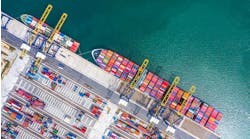President-elect Donald Trump's incoming administration has proposed trade policy changes that have the potential to reshape import costs and supply chain strategies. Although it remains unclear exactly how these proposals will come into effect, it is critical U.S. importers understand the practical steps to help protect margins and maintain importing advantage, regardless of how trade policy changes. The following guide, prepared by Geodis, a third-party provider of transportation, warehousing, global logistics and supply chain solutions, suggests practical actions you can take to reduce your tariff costs.
Step 1: Calculate Import Duty Exposure
· Analyze and evaluate your current import structure and tariff exposure (direct and indirect) within the first month to serve as the foundation for subsequent tariff reduction planning.
· From there, develop contingency plans for each potential case:
o Base case (10-20% universal tariff)
o High-impact case (60-100% China tariffs)
o Targeted increases (25% Mexico and Canada tariffs)
Step 2: Optimize Product Classifications and Documentation
· Document and classify products for accuracy and optimization according to the Harmonized Tariff Schedule (HTS) within 30-90 days.
· Note every product and its tariffs in detail to strengthen your product and tariff documentation processes and use tariff engineering to minimize import duty exposure.
Step 3: Develop Alternative Sourcing Strategies
· If your business imports from different countries, consider alternative suppliers. While not a fast process, begin in the first 90 days and complete within six months to a year.
· During evaluation, consider regions with lower tariff exposure, stable trade relationships, reliable infrastructure and compatible quality standards.
· Steps for developing alternative suppliers include:
o Initial supplier identification and screening
o Detailed capability assessment
o Sample production and testing
o Trial orders and quality verification
o Progressive volume scaling
Step 4: Protect Your Finances and Minimize Risks of Increased Tariffs and Import Duty
· Start this step within 30-90 days, although it can take time to complete.
· Conduct a cost impact analysis by modeling various scenarios to understand potential financial impacts and develop risk mitigation strategies to manage increased costs.
· Understand tariff implementation timing and impacts, remembering the charging of tariffs typically follows specific patterns.
· Review and adjust customs bond surety coverage as needed.
Step 5: Stay Updated on Changes to Tariff and Import Policies
· Monitor developments through multiple channels and adjust your strategy accordingly.
· Assign specific team members to monitor updates, create a regular review schedule, establish communication protocols with internal teams and external vendors, partners and customers, and document impact assessments and ensure these are built into your business strategy and risk programs.
Step 6: Manage Your Exposure to Chinese Imports and Tariffs
· Chinese imports could increase by 60-100%. If you import from China, it's urgent to prepare now.
· In the short-term, calculate your current Chinese import exposure, identify critical Chinese components requiring priority action, evaluate alternative sourcing options and analyze cost implications.
· In the long-term, consider developing comprehensive supplier diversification plans, establishing relationships in alternative markets, evaluating nearshoring opportunities and introducing robust origin verification processes.
The importers that thrive under new tariff policies will be those that prepare thoroughly and act decisively. By planning for the appropriate tariff protection actions now, you'll be better equipped to handle whatever changes come. For more information, visit GEODIS’ .



